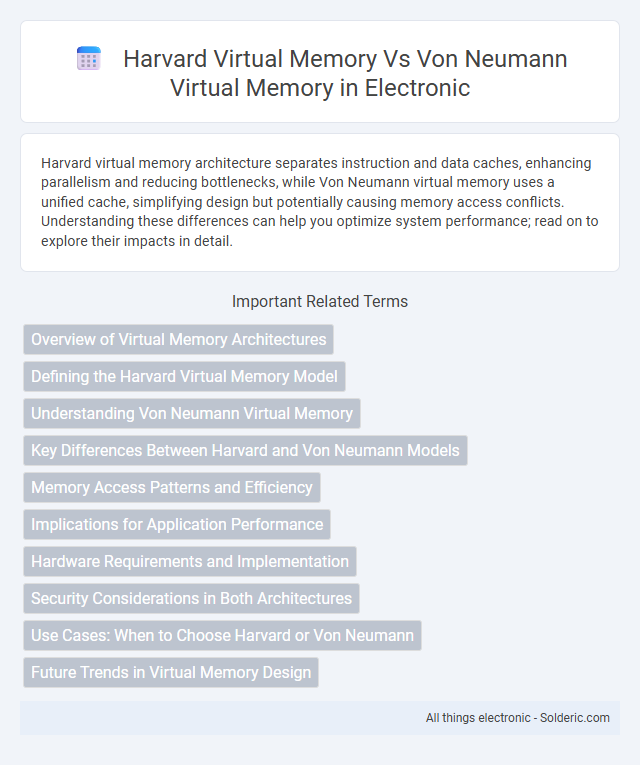Harvard virtual memory architecture separates instruction and data caches, enhancing parallelism and reducing bottlenecks, while Von Neumann virtual memory uses a unified cache, simplifying design but potentially causing memory access conflicts. Understanding these differences can help you optimize system performance; read on to explore their impacts in detail.
Comparison Table
| Feature | Harvard Virtual Memory | Von Neumann Virtual Memory |
|---|---|---|
| Architecture | Separate memory spaces for instructions and data | Unified memory for instructions and data |
| Memory Access | Parallel access to instruction and data memory | Single access path shared by instructions and data |
| Performance | Higher throughput due to simultaneous instruction/data fetch | Potential bottleneck as instructions and data share bus |
| Complexity | More complex memory management for separate spaces | Simpler memory management with unified address space |
| Code and Data Protection | Improved security via physically separated memories | Less secure; code and data share address space |
| Use Cases | Embedded systems, DSPs, systems requiring speed and security | General-purpose computing, flexibility in memory usage |
Overview of Virtual Memory Architectures
Harvard virtual memory architecture separates instruction and data memory into two distinct physical memory spaces, enabling simultaneous access and improved bandwidth efficiency. Von Neumann virtual memory uses a unified memory space for instructions and data, simplifying design but potentially causing bottlenecks due to sequential access. Understanding these differences in virtual memory architectures helps optimize your computing system's performance based on workload requirements and resource constraints.
Defining the Harvard Virtual Memory Model
The Harvard virtual memory model separates memory into distinct storage and signal pathways for instructions and data, enhancing parallelism and reducing bottlenecks. Unlike the Von Neumann model that uses a unified memory space, the Harvard architecture allows simultaneous access to program instructions and data, improving processor efficiency. This segregation supports more specialized cache designs, crucial in high-performance computing and embedded systems.
Understanding Von Neumann Virtual Memory
Von Neumann virtual memory integrates code and data within a single memory space, enabling the CPU to fetch instructions and read/write data from the same memory location. This architecture simplifies memory management but can cause bottlenecks known as the Von Neumann bottleneck, impacting system performance during simultaneous instruction and data access. Understanding Von Neumann virtual memory is essential for optimizing your software's memory access patterns and addressing potential latency in processing tasks.
Key Differences Between Harvard and Von Neumann Models
Harvard virtual memory architecture separates instruction and data storage, enabling simultaneous access and reducing bottlenecks, while Von Neumann virtual memory uses a single shared memory for both instructions and data, potentially causing latency due to sequential access. Harvard's distinct memory pathways enhance performance in parallel processing and embedded systems, whereas Von Neumann's unified memory simplifies design and is more flexible for general-purpose computing. Your choice between these models impacts overall system speed, efficiency, and complexity based on application requirements.
Memory Access Patterns and Efficiency
Harvard virtual memory architecture separates instruction and data memory, enabling simultaneous access which improves memory access patterns and increases throughput efficiency compared to Von Neumann architecture. Von Neumann virtual memory uses a unified memory space for instructions and data, often resulting in bottlenecks due to sequential access constraints, hindering efficiency in high-demand processing tasks. The Harvard model's parallel access optimizes cache utilization and reduces memory latency, enhancing overall system performance in complex computing environments.
Implications for Application Performance
Harvard virtual memory architecture separates instruction and data caches, enabling simultaneous fetch and execution that reduces bottlenecks and improves application performance in compute-intensive tasks. Von Neumann virtual memory uses a unified cache, which can lead to contention between instructions and data, potentially causing stalls and degraded performance under high memory demand. Applications requiring frequent memory access benefit from Harvard architecture's parallelism, while Von Neumann systems may incur latency due to sequential access constraints.
Hardware Requirements and Implementation
Harvard virtual memory architecture requires separate memory spaces and buses for instructions and data, necessitating distinct cache and memory management hardware to handle simultaneous access efficiently. In contrast, Von Neumann virtual memory architecture uses a unified memory space and bus, allowing simpler hardware design but potentially causing bottlenecks during instruction fetch and data access due to shared pathways. Implementation of Harvard virtual memory often leads to increased complexity and cost due to duplicated resources, while Von Neumann virtual memory benefits from streamlined hardware but demands sophisticated cache and virtual memory management to mitigate latency issues.
Security Considerations in Both Architectures
Harvard architecture separates instruction and data memory, enhancing security by isolating executable code from data, mitigating code injection and buffer overflow attacks. Von Neumann architecture uses a unified memory for both instructions and data, which poses higher risk of malicious code execution and data corruption due to shared access. Hardware-enforced memory protection mechanisms like NX (No-eXecute) bits and segmentation are crucial in Von Neumann systems to improve security while Harvard designs inherently reduce attack surfaces through memory separation.
Use Cases: When to Choose Harvard or Von Neumann
Harvard architecture is ideal for embedded systems and digital signal processing where separate instruction and data memory paths enhance speed and efficiency. Von Neumann architecture suits general-purpose computing tasks and applications needing flexible memory usage due to its unified memory structure. Your choice depends on prioritizing speed and specialized performance (Harvard) versus versatility and simpler design (Von Neumann).
Future Trends in Virtual Memory Design
Future trends in virtual memory design emphasize enhanced parallelism and security, with Harvard architecture enabling separate instruction and data caches to minimize latency, improving processor efficiency. Von Neumann architecture, while traditionally simpler, is evolving with advanced caching strategies and integrated memory management units to support complex workloads. Your system's performance will benefit from hybrid solutions that leverage the advantages of both architectures, optimizing virtual memory for next-generation computing demands.
Harvard virtual memory vs Von Neumann virtual memory Infographic

 solderic.com
solderic.com